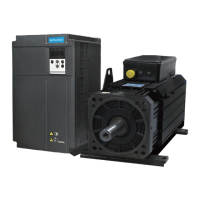5 Troubleshooting
5
- 44 -
Cause Conrming Methods Correctivee Action
2. The regenerative
resistor is too small or
short circuited.
If internal regenerative resistor is used
(H02-25 = 0), check whether
and D
are connected with a cable reliably. If yes,
measure resistance between C and D.
If external regenerative resistor is used
(H02-25 = 1/2), measure resistance
between
and C.
For regenerative resistor specication,
refer to Chapter 1.
If internal regenerative resistor is used and
the resistance is 0, use external regenerative
resistor (H02-25 = 1/2) and remove
cable between
and D. select external
regenerative resistor of the same resistance
and power as internal regenerative resistor.
If external regenerative resistor is used
and the resistance is smaller than H02-21
(allowed minimum value of regenerative
resistor), connect a new regenerative resistor
between
and C.
Make H02-26 (power of external regenerative
resistor) and H02-27 (resistance of external
regenerative resistor) consistent with external
regenerative resistor specication.
3. Motor cables are in
poor contact.
Check whether power cables of servo
drive and motor UVW cables are loose.
Fasten the cables that become loose or are
disconnected.
4. Motor cables are
grounded.
After ensuring power cables of servo drive
and motor cables are connected securely,
measure insulation resistance between
UVW of servo drive and ground cable (PE)
and check whether insulation resistance is
MΩ-level.
Replace motor if insulation is poor.
5. Motor UVW cables
are short circuited.
Disconnect motor cables and check
whether motor cables (U, V, W) are short
circuited and whether burrs exist.
Connect motor cables correctly.
6. Motor is damaged.
Disconnect motor cables and measure
whether resistance between motor cables
UVW is balanced.
Replace motor if resistance is unbalanced.
7. The gain setting is
improper and motor
oscillates
Check whether motor oscillates or
generates a shrill noise during motor
startup and running. You can view current
feedback by using the drive Inovance
servo commissioning software.
Adjust the gain.
8. Encoder cable
is incorrectly
wired, corrosive, or
connected loosely.
Check whether encoder cable you use is
standard conguration of Inovance. check
whether cable is aging, corrosive or is
connected loosely.
Set the S-ON signal to OFF and rotate
motor shaft manually. Check whether
H0B-10 (electric angle) changes as motor
rotates.
Re-weld, fasten or replace encoder cable.
9. Servo drive faulty.
The fault persists after motor cables are
disconnected and servo drive is powered
on again.
Replace the servo drive.
Er.207: Shaft D/Q current overow
Cause Conrming Methods Corrective Action
1. Shaft D/Q
current overows.
If the fault persists after you power on servo drive several times and
restore default setting, it indicates that the servo drive is faulty.
Replace the servo
drive.

